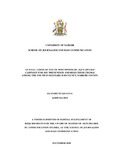An Evaluation of Youth Perception of Jijue Jipange Campaign for Hiv Prevention and Behaviour Change Among the Youth in Mathare Sub-county, Nairobi County

View/
Date
2018Author
Njuguna, Elizabeth
Type
ThesisLanguage
enMetadata
Show full item recordAbstract
The general objective of this study was to assess the youth perception of Jijue Jipange campaign. The specific objectives of this study were to: investigate the level of knowledge derived from Jijue Jipange campaign message by Mathare youth; investigate the influence of celebrities used in the campaign towards adoption of behaviour change by Mathare youth; find out how the youth in Mathare Sub-county perceived Jijue Jipange campaign message. In this study, both qualitative and quantitative research approach were used. The study population was 36,749 youth residing in Mathare Sub-county aged between 18 and 24. The sample size was 100 respondents. The method of data collection used was questionnaires, which were distributed to households in the Sub-county. Key informant interviews involving National AIDS Control Council campaign designer and communication officer were conducted. At community level, two HIV peer educators, two young HIV champions, and three youth leaders from three wards were interviewed with regards to Jijue Jipange campaign messages. The quantitative data collected was analysed using descriptive and inferential statistics and was presented in the form of tables and graphs. Qualitative data was presented in narrative form where key responses were presented in verbatim form. The key findings of the study were: Jijue Jipange campaign messages were clear since the language used – sheng language – was easy to understand and most youth identified with it. In order to understand the knowledge derived from the campaign messages, 60% of the respondents indicated that it is important to test for HIV while 9% indicated that they should not stigmatise those living with HIV.HIV testing message was more emphasised than the HIV stigma reduction message. In order to understand the influence of celebrities in the uptake of the new behaviour, 29% of the respondents indicated that celebrities were effective and well equipped with HIV information in the campaign’s message. However, those who indicated that the celebrities were not effective explained that some of the celebrities talked more of their music journey and their background thus missing out on the campaign’s objective. From the findings, campaign designers should ensure that the messages used in mass media campaigns are clearly elaborated and ambiguous words should not be used. This study can also recommend that the players involved in any HIV campaign should be well informed with what they are advocating for and so it is important for campaign designers to involve People Living with HIV to run with the campaigns message since they are well grounded on HIV issues and more especially educate the youth how to overcome HIV stigma.
Publisher
University of Nairobi
Rights
Attribution-NonCommercial-NoDerivs 3.0 United StatesUsage Rights
http://creativecommons.org/licenses/by-nc-nd/3.0/us/Collections
The following license files are associated with this item:

